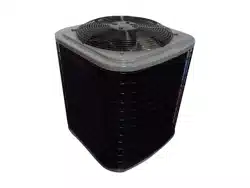Loading ...
Loading ...
Loading ...

START-UP PROCEDURE
1. Set indoor thermostat selector switch to OFF.
2. Turn ON all electrical disconnect devices.
3. If unit has a crankcase heater, energize the heater
and wait 24 hours before proceeding.
REFRIGERANT CHARGE
Outdoor units are shipped with a refrigerant charge to
match a specific indoor coil and 15 feet (4.6m) of
refrigerant line. If shorter or longer refrigerant lines or a
different indoor coil are used, the charge will have to be
adjusted.
For different line lengths, add or remove charge based on
0.6 ounces (17g) charge per foot (305mm) of difference.
For example, a 25 foot (7.6m) line set is 10 feet (3m)
longer than the specified 15 feet (4.6m). Add 0.6 ounces
(17g) charge for each of the extra 10 feet (3m):
10 x 0.6 = 6.0 ounces additional charge
(3m x 17g = 51g additional charge)
This outdoor unit is designed for use only with indoor coils
that utilize a TXV refrigerant metering device. With an
indoor TXV, use the subcooling method to make final
charge adjustments:
NOTE: Only use subcooling charging method when
• outdoor ambient temperature is between 70°F and 100°F
(21°C and 38°C)
• indoor temperature is between 70 ° and 80°F
(21°C and 27°C)
• line set is less that 80 feet (24.4m).
1. Operate unit a minimum of 15 minutes before
checking charge.
NOTE: If outdoor unit has a 2-speed fan motor,
motor will operate in low speed when outdoor
ambient temperature is below 82°F (28°C). Pull
one of the yellow low voltage wires off the fan
control and the unit will default to high speed fan for
servicing. Reconnect wire after servicing.
2. Measure liquid service valve pressure by attaching
an accurate gauge to service port.
3. Measure liquid line temperature by attaching an
accurate thermistor type sensor or electronic
thermometer to liquid line near outdoor coil.
4. Refer to unit rating plate for required subcooling
temperature.
5. Refer to Figure 11. Find the required liquid line
temperature where the rating plate subcooling
temperature intersects measured liquid service
valve pressure.
6. If the measured liquid line temperature is higher
than the chart number, add refrigerant to lower the
measured temperature.
4. Set indoor thermostat at desired temperature. Be
sure setpoint is below indoor ambient temperature
or thermostat will not call for cooling.
5. Set indoor thermostat selector switch to COOL.
Operate unit for minimum 15 minutes, then check
system refrigerant charge.
NOTE: When adding refrigerant, charge in liquid
form, using a flow restricting device, into the
suction port.
If the measured liquid line temperature is lower
than the chart number, reclaim refrigerant to raise
the measured temperature.
Tolerance is + 3°F (+1.7°C).
421 01 5002 01 11
Loading ...
Loading ...
Loading ...
